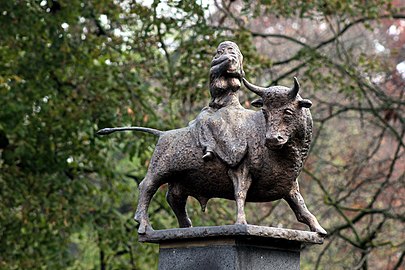Adenauer-Schuman memorial sign
The Adenauer-Schuman memorial in Bassenheim commemorates the meeting there between the French Foreign Minister Robert Schuman and the later German Chancellor Konrad Adenauer in October 1948. This meeting marks the beginning of a new era after the Second World War .
history
Konrad Adenauer, chairman of the CDU in the British occupation zone and president of the Parliamentary Council , which opened on September 1, 1948, endeavored to create a basis for bringing the not yet founded Federal Republic of Germany to the states of Western Europe. To do this, he wanted to meet a French statesman.
On October 8 and 9, 1948, Adenauer met Robert Schuman in the castle of the Counts of Bassenheim for secret conversations about which he wrote in his “Memoirs” 1965: “In October 1948 I was with Robert Schuman, the then Foreign Minister of France, met for the first time. I had had a very confidential conversation with him, which mainly concerned the Saar question . In this conversation, Schuman indicated that, with regard to the Saar, France saw a return to Germany as possible. What matters to France is to secure its economic interests. "
The fact that the meeting took place in the small town of Bassenheim was due to the fact that the French governor General Claude Hettier de Boislambert had resided in the castle in the palace gardens since 1945 . Boislambert later wrote: "It was conversations that had consequences."
Monument to the Franco-German rapprochement
It was not until 17 years later that the public found out about the encounter through Adenauer's “memories”, which Prime Minister Kurt Beck said in the celebration of the inauguration of the Adenauer Schuman memorial on June 17, 2012, among other things: “This was an important step on the way the Franco-German rapprochement. The Adenauer-Schuman memorial is a worthy memorial to commemorate this day. "
The monument is the work of the Thuringian sculptor Harald Stieding . On a dodecagon at Walpotplatz stand - based on the numerical symbolism of the Bible - twelve basalt steles of different heights, which symbolize the entirety of the European countries and, with the gradual increase from 60 centimeters to 2.40 meters, symbolize the never-ending process of Europe's development. On two of these steles, each 1.50 meters high, the bronze busts of Konrad Adenauer and Robert Schuman stand opposite one another. In the middle of the complex is a large bronze medallion with the Bassenheim coat of arms and the Bassenheim castle, surrounded by the twelve stars of the European flag .
The dominant point in the circle of the stelae is a picture of Greek mythology: Zeus , the father of the gods, transformed into a bull, with Europe , the daughter of the Phoenician king Agenor, after whom the continent was named. Like the two busts, this sculpture is cast from light bronze.
The main initiators for the establishment of the Adenauer-Schuman memorial sign were the former mayor of Bassenheim, Theobald Groß († 2019), Cord Michael Sander and Josef Seul.
annotation
- ↑ Some sources cite October 10, 1948 as the date of the talks.
- ↑ The Walpotplatz is named after the former rule of Bassenheim, the Count Walpot or Waldbott von Bassenheim.
Individual evidence
- ^ Theobald Groß: Gem between the Rhine and Eifel - Impressions from the historic Bassenheim . Bassenheim 2004.
- ↑ A worthy monument with great symbolism . In: rlp.de. Retrieved April 7, 2020.
- ↑ Prof. Dr. Peter Arlt: Laudation for the inauguration of Harald Stieding's European commemorative symbol . Retrieved April 7, 2020.
- ↑ Winfried Scholz: Reconciliation began in Bassenheim . In: Rhein-Zeitung Koblenz from June 18, 2012, p. 15.
Coordinates: 50 ° 21 ′ 37.9 ″ N , 7 ° 27 ′ 37.2 ″ E




